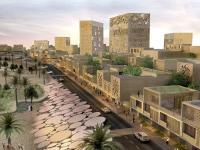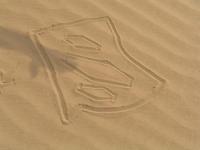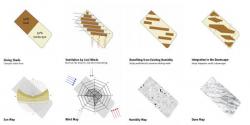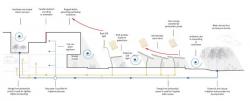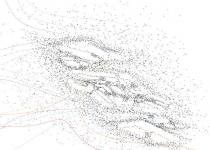“Xeritown” is a 59 hectare sustainable mixed-use development in one of the fastest growing cities of the world: Dubai. It provides housing for approximately 7000 inhabitants. It is located in Dubailand, a new extension of the city towards the inland desert. Instead of considering the site as a tabula rasa “Xeritown” takes the desert and local climate as a context within which the urban form emerges by working with the natural environment instead of against it.
In the design, the built up area has been compressed to occupy only 50% of the site as an immediate reaction to the sun conditions to achieve a compact shaded fabric: its structure is defined by alternating narrow pedestrian alleys and small squares, typical of Arabic towns. This urban tissue is divided in elongated islands that are orientated so to gain from the prevailing winds crossing the site. The cool breeze from the sea is channeled between the islands and through the longitudinal cuts in the urban fabric, while the hot wind from the desert is deviated above the development. Natural ventilation is enhanced by a rugged skyline breaking up air flows on the scale of both low rises and towers. Similar dynamics determine the formations of the dunes in the desert, thus the development appears as dunescape where the urban islands could be interpreted as a consolidation of the desert dunes.
The resulting landscape area is one of the design’s strongest assets. The landscape design draws on the existing potentially humid spots that are preserved thanks to a careful positioning of the islands. It is conceived as a series of humid zones in an arid setting and it profits from grey water, an inevitable byproduct of local human settlement. So the design not only builds on the present biodiversity of plants and animals, but enhances it, providing attractive designated areas. A focal part of the design is the edge between the urban fabric and the landscape. This is the moment in which architecture, infrastructure and landscape come together, coinciding with an intensification of human activity. Here people can walk under a shaded arcade looking at shops, or stroll along a promenade observing the landscape. A shading device is located here composed by photovoltaic panels which provide valuable energy to the site. The search for solutions that focus both on resource saving principles and on creating a pleasant environment for social interaction also determine the design of the architectural typologies, all of which benefit both climatically and visually from the proximity to the landscape.
The project applies a multitude of strategies for achieving an ecological quality and energy conservation like reducing energy demand by minimizing solar gains thanks to north-east orientation natural ventilation and earth pipes, dimmable LED street lighting, photovoltaic panels to generate low-voltage direct current electricity and roof top turbines; strategies for the conversion of recourses by the reduction of the demand of potable water thanks to low water-use appliances, grey water recycling for irrigation and water saving irrigation systems, low maintenance landscape, re-use of soil present on site and waste-recycling facilities, strategies to reduce carbon emissions by easy access to public transport and by extensive shaded and well ventilated pedestrian and cycling network.
Site Area: 590.000 m2 Bldg. Area: 214.000 m2 Gross Floor Area: 486.000 m2 Bldg. Coverage Ratio: 26 % Gross Floor Ratio: 83% Bldg. Scale: 12 Stories above Ground 2 Stories below Ground Max. Height: 45 m Landscape Area: 265450 m2 Street Parking Lot: 130 cars Garage Parking Lots: 3560
Program areas: Apartment housing: 356.650 m2 Triplex Apartments: 27.350 m2 Courtyard Houses: 23.650 m2 Detached Villas 46.000 m2 Community House: 8.050 m2 Retail: 6.600 m2 2 Mosques: 9.200 m2 Desert Life Museum: 2.150 m2 2 Kindergartens: 4.500 m2 Sport fields/Playground: 3.050 m2
SMAQ – architecture urbanism research {Berlin
2006
2008
Favorited 5 times
.jpg)
.jpg)

